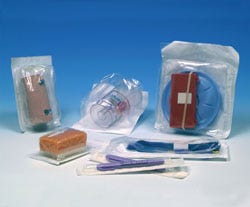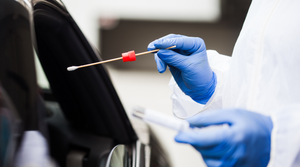New Films and Machinery Advance Medical Device Packaging
Suppliers of medical device packaging are seeking to reduce costs by improving processing cleanliness and implementing materials and systems innovations
November 30, 2012
According to a recent purchasing study conducted by Pharmaceutical & Medical Packaging News, pharmaceutical and medical device packaging professionals value quality above all other considerations when searching for suppliers. But price is a close second. While quality and cleanliness reign supreme when it comes to demands placed on suppliers, the competitive medical device industry is compelling manufacturers to reduce costs wherever possible. And packaging is often a target.
Quality and Cleanliness
As converters work to devise new cost-saving materials and packaging formats, they are also fielding requests for more data and additional internal controls to ensure that they are maintaining quality standards. "FDA has significantly increased its resources for inspections and analysis since 2009," explains Nicholas Berendt, director of global medical market development at Sealed Air Medical Applications (Elmwood Park, NJ). "We are seeing more requests for multilevel documentation from our customers, and we are experiencing more frequent customer audits at our facilities as part of the increased trend in regulatory engagement."
|
Forming films from Printpack Medical eliminate the need to add costly secondary coatings to breathable substrates. |
In addition to the heightened demand for more data and internal controls, demands for increased hygiene measures are increasing, Berendt notes. "We were getting customer requests to move from hair nets to full hoods and gowns in our cleanrooms. We are meeting this request." In addition, Sealed Air has upgraded its cleanroom facilities in order to achieve full ISO 13485 and ISO 14644-1 accreditation for its thermoforming operations.
Like Sealed Air, Printpack Medical (Atlanta) is upgrading all of its converting operations in Marshall, NC, to meet ISO Class 100,000 cleanroom standards, states Brad Walker, the company's vice president and general manager. "We see trends toward more FDA oversight and increased quality. Thus, we are making enhancements to Marshall. All converting equipment will be in the new cleanroom space." The facility will employ both automation and vision inspection systems in order to ensure zero defects and the integrity of the sterility barrier. To achieve these goals, the company is installing cameras to compare product to a standard and identify defects such as wrinkles and gels. The upgraded lines will also be able to eliminate deviations immediately.
Jumping on the cleanliness bandwagon, Perfecseal (Oshkosh, WI) is equally focused on quality. "We have reduced sources for particulates and have certified to cleanroom standards in most of our production areas," remarks Ed Haedt, the company's vice president of marketing. "Also, we have incorporated vision technologies to help catch and quarantine defective product before it gets to our customers." Thus, the company intends to concentrate on offering packaging products that achieve high quality levels while keeping costs in check.
The Material Makes the Package
To meet manufacturers' requests to cut costs, suppliers of medical device packaging are also striving to implement materials innovations. "Device manufacturers are facing tremendous cost pressures," says Michael Wollberg, sales manager at Printpack Medical. "It is more imperative than ever for us to deliver greater value through innovative products. Our new KwikBreathe pouches and DirectSeal forming films eliminate the need to add costly secondary coatings to breathable substrates."
Similarly, Perfecseal is developing stronger yet lower-weight nylon-reinforced film materials for medical device packaging applications. In contrast to monolayer or non-nylon-containing materials, these thinner films exhibit substantial light-weighting and downgauging properties. "An engineered approach to incorporating a high-performance polymer like nylon results in cost-effective films that have substantially higher durability than nonnylon materials," according to Haedt. "The term durability encompasses the overall performance of the film, including puncture resistance, repetitive flex-crack resistance, abrasion resistance, and other tensile-related properties."
|
Offering a range of pouches, Perfecseal is developing stronger yet lower-weight, thinner nylon-reinforced film materials for medical device packaging applications. |
For example, the company's PerfecForm ICE forming film and Perfecflex QE bag film series 36670 offer some of the highest performance levels per unit thickness of any films in the industry, Haedt claims. Perfecseal has also developed Opalen MD, a proprietary nylon/polyethylene coextruded film designed for lighter-weight applications that can be run at high speeds. "Measuring 55 µm, this film is thin, but due to the nylon component, it has excellent puncture resistance and tensile strength," Haedt adds. The film can be sealed to such substrates as films, heat-seal coated and uncoated papers, and Tyvek.
Downgauging is a concern for other companies as well. Thus, Sealed Air's Latitude ML29C forming film enables medical device manufacturers to downgauge from other films by as much as 30%, Berendt comments. As a result, one of the company's customers has moved from a 10-mil EVA/Ionomer/EVA film to a 7-mil Latitude film to package a procedural kit that includes a syringe and other light consumables for the U.S. market. Because the film is thinner than competing films with equivalent or better mechanical properties, more material can be wound on 50-lb rolls, according to Berendt. Thus, the amount of downtime required for roll changeovers has been reduced, leaving more time for production.
Nexmark, another film offered by Sealed Air, is also being investigated for its savings potential. Incorporating a photochromatic additive that enables laser printing, the film eliminates the need for preprinted rollstock inventory, allowing shorter batch quantities and thereby reducing working capital, according to Berendt. In addition, the company is researching new resins and developing qualified alternatives during new product development. "Shortages of materials can happen, so we are establishing a safety net," Berendt explains. "Thus, we are building data on alternatives and filing it away in case there is ever the need to switch."
Manufacturing the Films
To manufacture films that meet the increasing demands for high performance and cost savings, packaging companies are using retrofitted or new film manufacturing technology that they hope will result in significant improvements. For example, Sealed Air has adapted its packaging equipment to accommodate Cryovac CT-301, a 30-gauge, microlayered shrink film offering 7.5 lb of impact strength. Used in shrink tunnels and on flow wrappers, this film can be used to collate different products and to provide tamper evidence. "We identified technology from a different industry and adapted it to work on our machines," Berendt notes. "This film offers a huge improvement in strength at half the thickness [of other films]."
Perfecseal is also adapting its equipment to meet the needs of new film technologies. For example, it is employing film-sealant technology to engineer medical-grade peel-opening systems that are designed to provide high seal strength and a fiber-free seal. Such systems are also designed to produce peelable, uncoated paper and medical-grade Tyvek. "We began by introducing our Clean Peel technology several years ago for Tyvek/film pouches and Tyvek/forming film for form-fill sealing systems," Haedt comments. "The success of that technology has been translated into more cost-effective paper/film options under the PaperLock system name."
While the company's ability to seal pouch-forming films directly to uncoated papers is not new, providing packaging materials with medical device-quality peel appearance and fiber-free peel seals at the industry target of 1-lb seal strength is new. "We combined our highly popular PerfecForm ICE film platform with this new sealing technology under the PaperLock CP system," Haedt notes. "This system can form a range of web thicknesses and paper thicknesses to cover a broad range of package performance requirements."
Not to be left behind, Printpack Medical has installed its first machine for supporting a full line of pouches, including Tyvek-to-film, paper-to-film, film-to-film, foil-to-foil, foil-header, and abrasion-resistant KwikBreathe pouches, Wollberg says. "This will complement the existing line of header bags, forming films, breathable top webs, high-impact polystyrene (HIPS) sheet, and film and foil laminates."
About the Author(s)
You May Also Like




